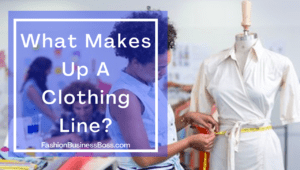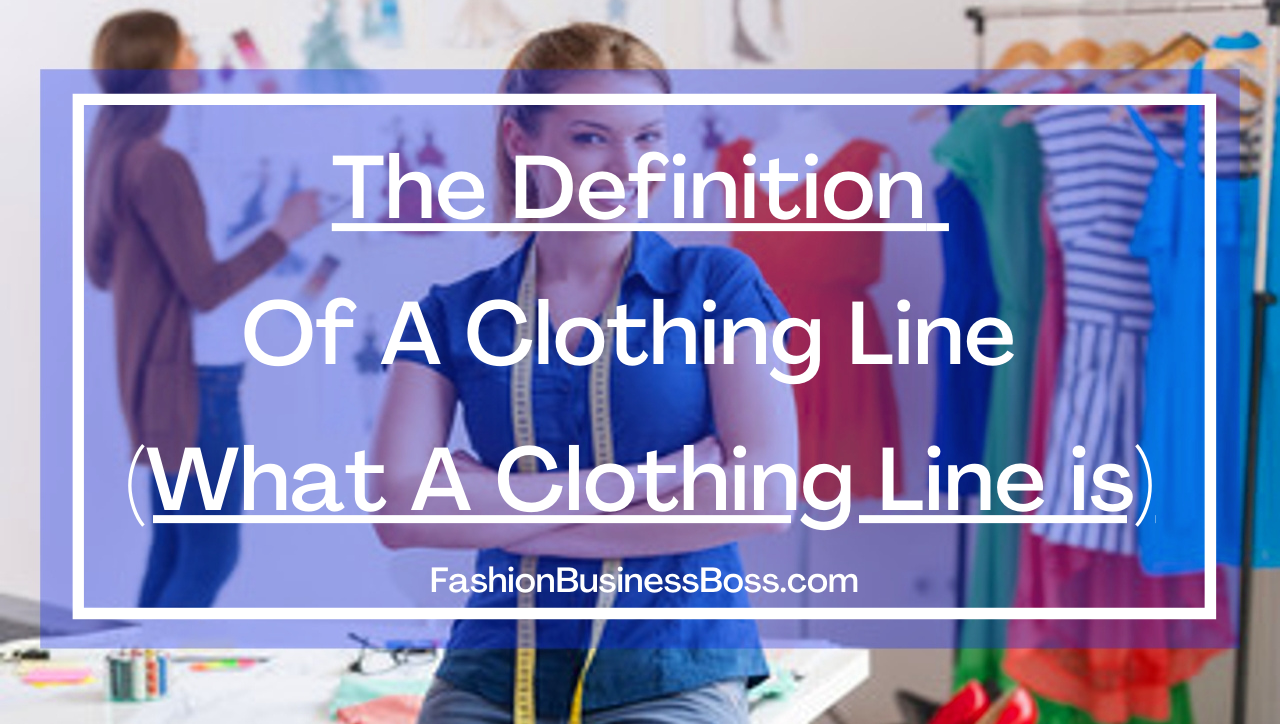While passion for fashion is required before starting your clothing line, it’s also important to know what you’re stepping into before you start creating. What exactly is a clothing line, and what does it entail?
The definition of a clothing line is the specific grouping of items created for a target demographic that is sold in retail locations or online. A fashion designer will produce a clothing line within their company as a part of their company’s collection.
Knowing what exactly a clothing line is can be integral to your business, but what makes up a clothing line? Have clothing lines always been the trend, or is it a recent idea? Where does it fall within the levels of the fashion industry? What can you do with a clothing line? Read on to find out more.
History of the Fashion Industry
While the clothing industry was intended for the wealthy for most of history, it was mostly utilitarian for the bulk of the world until the 19th century. Up until then, it was typically regarded as simply something that must be worn—unless you were royal or wealthy.

Prior to the 20th Century, fashion designers really became popular and famous during the early 1700s in French culture. While this may not come as a surprise, considering the French’s focus on fashion, Françoise Leclerc, dressmaker to the Queen of France, truly became a hot commodity between the rich French aristocracy.
Following Leclerc in popularity, individuals such as Mademoiselle Alexandre and Le Sieur Beaulard both started gaining their own traction until Rose Bertin, the dressmaker to Queen of France Marie Antoinette, was dubbed the “Minister of Fashion”.
Bertin, with his interesting designs that one would not expect out of that time period—Marie Antoinette’s simple muslin shift dresses or riding breeches in the 1700s—started to set both he and the French apart from other Western fashion designers. As high fashion continued to develop through the 1800s and department stores became more popular among the masses, fashion trends soon became more accessible to the less noble.
So, what changed? By the end of the 19th century, women were becoming more financial stable—which meant the demand for high fashion clothing became higher. Because of this, more and more fashion designers came onto the market, all with differing designs.
What is the true power of a clothing line, though? History and fashion can sometimes go hand in hand, like with Paul Poiret. Prior to his designs, which notably started coming out around the 1910s, women wore corsets or stays. While their construction and use shifted throughout the Renaissance to the 20th century, by the time he designed clothing, that idealized version of the tight Victorian corsets were extremely popular. He decided to stop creating designs that used such undergarments—effectively pushing the fashion industry towards creating the brassiere and allowing for more freedom for women’s fashion.
The 1920s and 1930s continued to thrive within the fashion industry, even with the Great Depression, and especially with World War I and its aftermath. Clothing became simpler and less frivolous, dress codes relaxed, and skirts began to shorten to save fabric. While this was all a result of wartime, these trends continued throughout the decades, helping to lead to the more casual fashion that started to develop in the 1950s.

Many of the more traditional fashion houses that we know today—Balenciaga, Givenchy, Dior, to name a few—started post World War II, and as fabrics and the science of fashion changed, looks changed. Hollywood had a profound effect on fashion, as now more of the masses were looking on celebrities and wanting to wear what they wore.
Fashion houses took advantage of this, and continue to do so—celebrities dictate what trends people follow or what clothing they wear. Whether it’s Twiggy, Jackie Kennedy, Billie Eilish, Marilyn Monroe, Madonna, Kim Kardashian, or Princess Diana, people wanted to copy their looks.
What does this history mean to your clothing line? Learn from the past and plan for the future. Your ideas could change an entire industry, or current events can change your entire clothing line. Stay on top of both trends and events to see how it can affect how you create your line.
Clothing Boutique Equipment Checklist
The Four Levels of the Fashion Industry
Now, within our modern age of clothing creation, there are four stages within the fashion industry that you can be a part of with your business. Understanding both the history and the makeup of the fashion industry can not only help you in making your business decisions, but it can help you make predictions on what may change and morph in the fashion industry in the future.
The four levels of the fashion industry are raw material production, fashion goods production, retail sales, and advertising and marketing. What does that mean for you?
Raw material production is the part of the fashion industry that can be considered the most important—this portion creates the materials that are needed within the other three levels of the fashion industry. Fibers like hemp, cotton, silk, and wool are created within this step, along with textiles—any sort of fabric you may need in your clothing line.
Fashion goods production is the next level, which takes the textiles and fibers created in the raw material production level and creates the clothing that you will sell in your stores. Many clothing lines participate specifically in this level of the fashion industry, as creating your own clothing line means manufacturing the clothing and not just purchasing from a third-party seller. Fashion design and marketing is also part of this sector.
Retail sales is the next level, and it makes sense—once you have your goods, you’re ready to put them on shelves. These businesses take the goods created in the last two levels and puts them on shelves.
Advertising and marketing are where the clothing industry spends a lot of its profits—but don’t think that that’s all they do in this level. This level also encompasses businesses who organize fashion shows.
Pros And Cons Of Starting A Clothing Line
What makes up a clothing line?
When it comes to creating your own clothing line, you have almost unlimited options in your decision making. If you’re looking to branch into a clothing line, some of the items you can sell include:

- Accessories
- Blouses
- Children’s Apparel
- Designer Fashion
- Dresses
- Evening Apparel
- Jewelry
- Maternity
- Outerwear
- Pants
- Plus Size
- Shorts
- Skirts
- Sportswear
- Uniforms
Clothing Lines: What do they entail?
Opening up a clothing line isn’t as simple as just designing a few items and putting them on a rack. There are other steps that you must take to ensure success when creating your new clothing line.
Firstly, you have to stay on top of all the latest trends and looks that may be upcoming. You want to make sure you’re at the top of the list when it comes to selling your new designs, and without knowing what’s coming, you can’t do that. Do research on other fashion houses, look at what celebrities are wearing, and monitor recent trends to find out where trends are moving.
You should also be working with your target demographic. While this goes hand in hand with researching trends, you should also know what your customers are looking for. Sometimes their wants and needs are not the same as current trends.

Look into manufacturing and how you can improve on your items without breaking the bank. People are always looking for inexpensive items that are on trend, so do your due diligence to make sure you can pass the savings onto your customers.
Continue working on your brand. Your brand is what attracts people and your items are what keep them coming back. Make sure you are marketing in a cohesive marketing strategy and maintaining the quality of your brand through your items.
Knowing what a clothing line is may be integral to your business, but knowing what you can do with it—like completely shifting an entire industry and look, like Paul Poiret—is what makes your business a force to be reckoned with. Take your knowledge and use it as you develop your own clothing line.
Ten Fashion Business Management Tips
RELATED QUESTIONS
What type of shop sells a clothing line?
When you’re looking at the types of fashion businesses you can create, there are almost unlimited possibilities. Creating your own clothing line means that you will most likely be selling your own brand in a retail shop. You also have the opportunity to work with an import or wholesaler so other retail shops can purchase your clothing line to sell in their stores. If you’re looking to create a specialized store like one selling cultural clothing, bridal wear, or even a sportswear shop, you can do that too with the proper clothing line.
What experience do I need to start a clothing line?
No experience is needed to start a clothing line, just a passion for the industry. A degree in a related field like fashion design, art, or business can help you, but they are not required. Those who are passionate, creative, and frugal will be able to start their own clothing line without a degree.
To learn more about how to start your own fashion clothing line check out my startup documents here
Please note: This blog post is for educational purposes only and does not constitute legal advice. Please consult a legal expert to address your specific needs.

Meet Shawn Chun: Entrepreneur and Fashion Business Fan.
I’m a happy individual who happens to be an entrepreneur. I have owned several types of businesses in my life from a coffee shop to an import and export business to an online review business plus a few more and now I create online resources for those interested in starting new ventures. It’s demanding work but I love it. I do it for those passionate about their business and their goals. That’s why when I meet a designer or boutique owner at a craft fair, farmers market, retail location or anywhere else I see myself. I know how hard the struggle is to retain clients, find good employees and keep the business growing all while trying to stay competitive.
That’s why I created Fashion Business Boss: I want to help fashion business owners like you build a thriving business that brings you endless joy and supports your ideal lifestyle.

